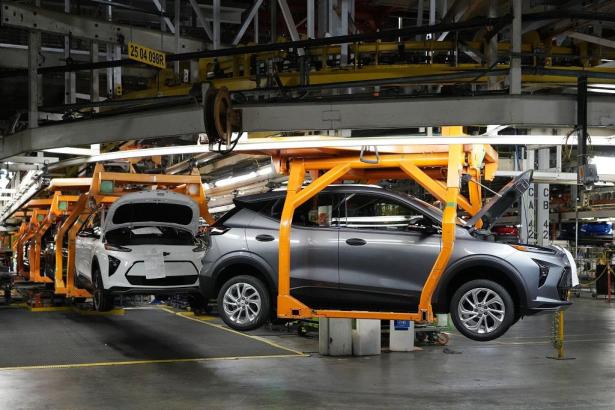One of the biggest climate challenges for any country will be decarbonizing transportation. According to the EPA, about 29 percent of greenhouse gas emissions come from transportation after accounting for electricity use, just behind industrial production at 30 percent.
Fortunately, the electric-vehicle transition is happening faster than many expected, despite concerns earlier in the year that automakers were pushing back their EV rollouts. Clearly, that is not a response to consumer demand. A new report on the state of the American car market, again from the EPA, has the goods. The EV share of new car purchases increased from 1.8 percent in 2020, to 3.2 percent in 2021, to 5.2 percent in 2022, to an estimated 9.8 percent in 2023. Plug-in hybrid vehicles, meanwhile, increased from 0.5 percent to 2 percent.
In other words, the EV share of new cars increased more than fivefold in three years, while the share of plug-in hybrids quadrupled. At that pace of acceleration, EVs will make up half of new car sales by 2026 or so. These two developments reduced the emissions of the vehicle fleet by roughly 6 percent in 2022, and perhaps 11 percent in 2023.
It will no doubt be many decades before the last gas-powered car leaves the road. But the average car does not last that long—just over 12 years, as of 2022. So if these trends hold up, the U.S. vehicle fleet will be dramatically more electrified in a short space of time.
There is every reason to think that these trends will continue, at least on the current policy track. The Inflation Reduction Act provides ten years of secure subsidies for EVs, and every auto manufacturer around the world has made huge investments—even if some have been delayed somewhat—around the assumption that EVs are where the industry is going over the medium term.
That said, Donald Trump has promised to tear up the IRA if he is elected in 2024, adding a giant climate risk on top of his plot to end democracy. But so long as that doesn’t happen, for the next decade at least, every year a larger and larger share of new cars will be electric, and they will displace a larger and larger share of the existing gas-powered fleet. That in turn will take a larger and larger bite out of transportation emissions and U.S. oil consumption—and that’s a big deal globally, as America is still the largest consumer of oil in the world, gobbling up nearly 20 percent of the total supply as of 2022.
The benefits don’t stop there. In addition to climate, there will be increasing health benefits from cutting down on toxic smog and noise produced by internal combustion engines. Consuming less and less oil will undermine the wealth and power of reactionary petro-dictatorships like Saudi Arabia and Russia abroad, and fossil fuel barons like David Koch at home. And as solar and wind continue to replace electricity generated by coal and gas, the secondary emissions produced by vehicle charging will fall as well. All that is to the good.
Now, it should be admitted that transitioning from gas-powered to electric vehicles by itself is far from ideal, from either a climate or a human welfare perspective. EVs require a tremendous amount of resources, particularly the enormous and heavy American-style models. Many of those resources are still produced with carbon-intensive processes, like steel (though there is developing progress on that front). And the increased weight of U.S. EVs, thanks in part to the battery packs and in part to the annoyingly dominant crossover SUV models, harms road surfaces and will increase municipal repair costs.
More generally, it’s been obvious for decades that the total reorientation of the American built environment around cars and driving has been a disaster, contributing to a crisis of inactivity, loneliness, and nearly 120 people per day killed from collisions. If we could, it would be best to dedicate marginal manufacturing capacity to improved public transit, electric bikes, scooters, and so on, because they could replace most car trips at a fraction of the cost in energy and resources. Indeed, e-bikes have displaced global oil demand by something like four times as much as all EVs, mostly thanks to their heavy adoption in China and elsewhere.
But reorienting sprawling American cities to be safe for bikes and pedestrians—already well in progress in some cities—will take years of bitter fighting with NIMBYs and ingrained, knee-jerk car supremacy. Even New York City, where a majority of households don’t own cars, struggles with elementary stuff like dedicated lanes for bikes and buses. And in any case, even the least car-dependent cities on Earth (like, say, Amsterdam) still have many vehicles for taxis, deliveries, and those stubborn people who just like to drive.
It’s unfortunate that America didn’t get started on its decarbonization and energy efficiency program 30 years ago. And of course, every city and town should do its utmost to make the roads safe for cyclists and pedestrians, so people can take as many trips as possible without having to fire up a three-ton piece of machinery. But the hour is so late climate-wise that we need to smash down emissions as fast as possible any way we can. The fact that the share of EVs sold is nearly doubling every year is very good news.
Ryan Cooper is the Prospect’s managing editor, and author of How Are You Going to Pay for That?: Smart Answers to the Dumbest Question in Politics. He was previously a national correspondent for The Week. His work has also appeared in The Nation, The New Republic, and Current Affairs.
Read the original article at Prospect.org.
Used with the permission. © The American Prospect, Prospect.org, 2023. All rights reserved.
Click here to support the Prospect's brand of independent impact journalism.


Spread the word